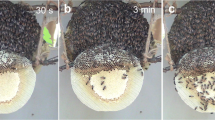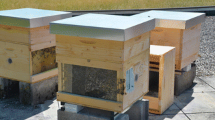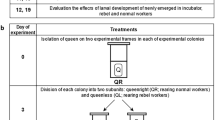Abstract
Honeybees (Apis mellifera) are able to regulate the brood nest temperatures within a narrow range between 32 and 36°C. Yet this small variation in brood temperature is sufficient to cause significant differences in the behavior of adult bees. To study the consequences of variation in pupal developmental temperature we raised honeybee brood under controlled temperature conditions (32, 34.5, 36°C) and individually marked more than 4,400 bees, after emergence. We analyzed dancing, undertaking behavior, the age of first foraging flight, and forager task specialization of these workers. Animals raised under higher temperatures showed an increased probability to dance, foraged earlier in life, and were more often engaged in undertaking. Since the temperature profile in the brood nest may be an emergent property of the whole colony, we discuss how pupal developmental temperature can affect the overall organization of division of labor among the individuals in a self-organized process.


Similar content being viewed by others
Abbreviations
- AFF:
-
Age of first foraging flight
- JH:
-
Juvenile hormone
References
Amdam GV, Norberg K, Fondrk MK, Page RE (2004) Reproductive ground plan may mediate colony-level selection effects on individual foraging behavior in honey bees. Proc Natl Acad Sci USA 101:11350–11355
Amdam GV, Csondes A, Fondrk MK, Page RE (2006) Complex social behaviour derived from maternal reproductive traits. Nature 439:76–78
Beshers SN, Huang ZY, Oono Y, Robinson GE (2001) Social inhibition and the regulation of temporal polyethism in honey bees. J Theor Biol 213:461–479
Calderone NW, Page RE (1988) Genotypic variability in age polyethism and task specialization in the honey bee, Apis mellifera (Hymenoptera: Apidae). Behav Ecol Sociobiol 22:17–25
Deseyn J, Billen J (2005) Age-dependent morphology and ultrastructure of the hypopharyngeal gland of Apis mellifera workers (Hymenoptera, Apidae). Apidologie 36:49–57
Fahrenholz L, Lamprecht I, Schricker B (1989) Thermal investigations of a honey bee colony: thermoregulation of the hive during summer and winter and heat production of members of different bee castes. J Comp Physiol B 159:551–560
Fewell JH, Page RE (2000) Colony-level selection effects on individual and colony foraging task performance in honeybees, Apis mellifera L. Behav Ecol Sociobiol 48:173–181
Giray T, Robinson GE (1994) Effects of intracolony variability in behavioral-development and plasticity of division of labor in honey bee colonies. Behav Ecol Sociobiol 35:13–20
Groh C, Tautz J, Rössler W (2004) Synaptic organization in the adult honey bee brain is influenced by brood-temperature control during pupal development. Proc Natl Acad Sci USA 101:4268–4273
Harrison JM (1987) Roles of individual honeybee workers and drones in colonial thermogenesis. J Exp Biol 129:53–61
Himmer A (1927) Ein Beitrag zur Kenntnis des Wärmehaushaltes im Nestbau sozialer Hautflügler. Z Vgl Physiol 5:375–389
Huang ZY, Robinson GE (1992) Honeybee colony integration: Worker-worker interactions mediate hormonally regulated plasticity in division of labor. Proc Natl Acad Sci USA 89:11726–11729
Huang ZY, Robinson GE (1995) Seasonal changes in juvenile hormone titers and rates of biosynthesis in honey bees. J Comp Physiol B 165:18–28
Huang ZY, Robinson GE (1996) Regulation of honey bee division of labor by colony age demography. Behav Ecol Sociobiol 39:147–158
Huang ZY, Robinson GE, Borst DW (1994) Physiological correlates of division of labor among similarly aged honey bees. J Comp Physiol A 174:731–739
Hunt GJ, Amdam GV, Schlipalius D, Emore C, Sardesai N, Williams CE, Rueppell O, Guzman-Novoa E, Arechavaleta-Velasco M, Chandra S, Fondrk MK, Beye M, Page RE (2007) Behavioral genomics of honeybee foraging and nest defense. Naturwissenschaften 94:247–267
Jones JC, Myerscough MR, Graham S, Oldroyd BP (2004) Honey bee nest thermoregulation: diversity promotes stability. Science 305:402–404
Jones JC, Helliwell P, Beekman M, Maleszka R, Oldroyd BP (2005) The effects of rearing temperature on developmental stability and learning and memory in the honey bee, Apis mellifera. J Comp Physiol A 191:1121–1129
Kleinhenz M, Bujok B, Fuchs S, Tautz J (2003) Hot bees in empty broodnest cells: heating from within. J Exp Biol 206:4217–4231
Kraus B, Velthuis HHW, Tingek S (1998) Temperature profiles of the brood nests of Apis cerana and Apis mellifera colonies and their relation to Varroosis. J Apic Res 37:175–181
Kronenberg F, Heller HC (1982) Colonial thermoregulation in honey bees (Apis mellifera). J Comp Physiol B 148:65–76
Kryger P, Kryger U, Moritz RFA (2000) Genotypical variability for the task of water collecting and scenting in a honey bee colony. Ethology 106:769–779
LeConte Y, Mohammedi A, Robinson GE (2001) Primer effects of a brood pheromone on honeybee behavioural development. Proc R Soc Lond B 268:1–6
Leoncini I, LeConte Y, Costagliola G, Plettner E, Toth AL, Wang M, Huang Z, Bécard J-M, Crauser D, Slessor KN, Robinson GE (2004) Regulation of behavioral maturation by a primer pheromone produced by adult worker honey bees. Proc Natl Acad Sci USA 101:17559–17564
Levin CG, Collison CH (1990) Broodnest temperature differences and their possible effect on drone brood production and distribution in honeybee colonies. J Apic Res 29:35–45
Lindauer M (1954) Temperaturregulierung und Wasserhaushalt im Bienenstaat. J Comp Physiol A 36:391–432
Linksvayer TA (2006) Direct, maternal and sibsocial genetic effects on individual and colony traits in an ant. Evolution 60:2552–2561
Page RE, Fondrk MK, Hunt GJ, Guzman-Novoa E, Humphries MA, Nguyen K, Greene AS (2000) Genetic dissection of honeybee (Apis mellifera L.) foraging behavior. J Hered 91:474–479
Pankiw T (2004) Worker honey bee pheromone regulation of foraging ontogeny. Naturwissenschaften 91:178–181
Pankiw T, Page RE (2000) Response thresholds to sucrose predict foraging division of labor in honeybees. Behav Ecol Sociobiol 47:265–267
Pankiw T, Page RE (2001) Genotype and colony environment affect honeybee (Apis mellifera L.) development and foraging behavior. Behav Ecol Sociobiol 51:87–94
Pankiw T, Page RE (2003) Effect of pheromones, hormones and handling on sucrose response thresholds of honey bees (Apis mellifera L.). J Comp Physiol A 189:675–684
Pankiw T, Huang ZY, Winston ML, Robinson GE (1998) Queen mandibular gland pheromone influences worker honey bee (Apis mellifera L.) foraging ontogeny and juvenile hormone titers. J Insect Physiol 44:685–692
Robinson GE (1992) Regulation of division of labor in insect societies. Annu Rev Entomol 37:637–665
Robinson GE, Page RE (1989) Genetic determination of nectar foraging, pollen foraging, and nest-site scouting in honey bee colonies. Behav Ecol Sociobiol 24:317–323
Robinson GE, Vargo EL (1997) Juvenile hormone in adult eusocial hymenoptera: gonadotropin and behavioral pacemaker. Arch Insect Biochem Physiol 35:559–583
Rösch GA (1925) Untersuchungen über die Arbeitsteilung im Bienenstaat, 1. Teil: Die Tätigkeiten im normalen Bienenstaate und ihre Beziehungen zum Alter der Arbeitsbienen. Z Vgl Physiol 6:264–298
Schulz DJ, Robinson GE (1999) Biogenic amines and division of labor in honey bee colonies: behaviorally related changes in the antennal lobes and age-related changes in the mushroom bodies. J Comp Physiol A 184:481–488
Schulz DJ, Robinson GE (2001) Octopamine influences division of labor in honey bee colonies. J Comp Physiol A 187:53–61
Schulz DJ, Barron AB, Robinson GE (2002) A role for octopamine in honey bee division of labor. Brain Behav Evol 60:350–359
Seeley TD (1995) The wisdom of the hive. Harvard University Press, Cambridge, MA
Southwick EE (1982) Metabolic energy of intact honey bee colonies. Comp Biochem Physiol A 71:277–281
Southwick EE, Heldmaier G (1987) Temperature control in honey-bee colonies. Bioscience 37:395–399
Sullivan JP, Jassim O, Fahrbach SE (2000) Juvenile hormone paces behavioral development in the adult worker honey bee. Horm Behav 37:1–14
Tautz J, Maier S, Groh C, Rössler W, Brockmann A (2003) Behavioral performance in adult honey bees is influenced by the temperature experienced during their pupal development. Proc Natl Acad Sci USA 100:7343–7347
Wagener-Hulme C, Kuehn JC, Schulz DJ, Robinson GE (1999) Biogenic amines and division of labor in honey bee colonies. J Comp Physiol A 184:471–479
Wilson EO (1971) The insect societies. Harvard University Press, Cambridge, MA
Winston ML (1987) The biology of the honey bee. Harvard University Press, Cambridge, MA
Wolf JB, Brodi ED III, Cheverud JM, Moore AJ, Wade MJ (1998) Evolutionary consequences of indirect genetic effects. Trends Ecol Evol 13:64–69
Acknowledgments
We thank the DFG for funding (RM) and K. Dahlke, T. Janik, C. Opitz, T. Schnelle, M. Ellis, C. Nossol, A. Schmidt and M. Thoss for helping with the behavioral observations and the anonymous reviewers for helpful comments on the manuscript. All our experiments complied with the current German laws and also with the “Principles of animal care”, publication No. 86-23, revised 1985 of the National Institute of Health.
Author information
Authors and Affiliations
Corresponding author
Rights and permissions
About this article
Cite this article
Becher, M.A., Scharpenberg, H. & Moritz, R.F.A. Pupal developmental temperature and behavioral specialization of honeybee workers (Apis mellifera L.). J Comp Physiol A 195, 673–679 (2009). https://doi.org/10.1007/s00359-009-0442-7
Received:
Revised:
Accepted:
Published:
Issue Date:
DOI: https://doi.org/10.1007/s00359-009-0442-7




